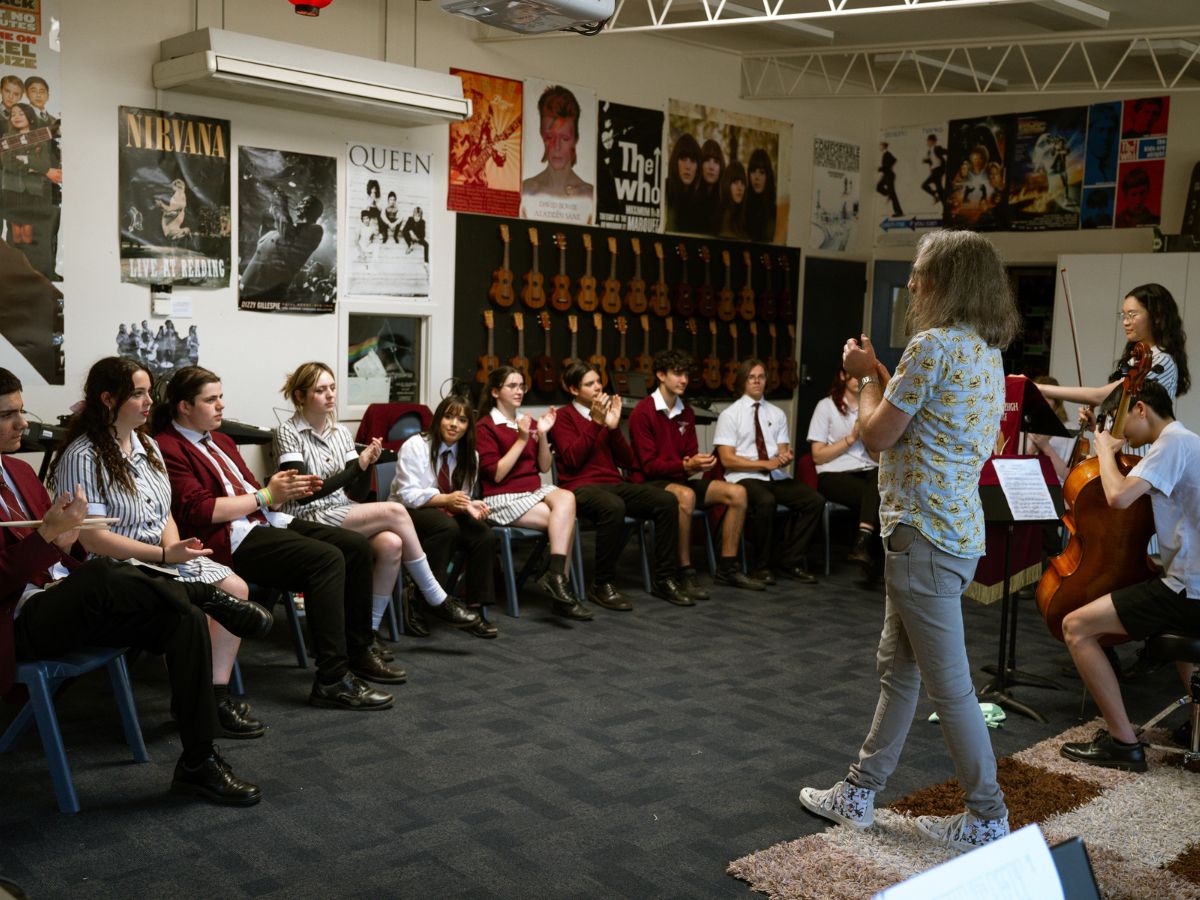Michelle Grace Hunder
Beyond the Classroom: How Teaching Has Changed in the 21st Century
How teachers in 2024 can navigate the new world of education and bring their best for the next generation of students
In Partnership with The Australian Government
Social media, multiple screens, and mental health.
This is what today’s teachers are working with in the current climate of global information sharing, diverse personalities, and technology.
According to Matt Barber, Aidan Prewett and Luke Springer, three teachers interviewed for the Rolling Stone AU/NZ series ‘Be That Teacher’, the world of education has evolved a lot over the years. “I started teaching in 2008 and at the time, it felt like it was more common for students to be pushed into a mould that most of them wouldn’t naturally fit,” shares Aidan.
There’s been a positive shift since then. Today, teachers have access to more tools than ever, and are encouraged to find new and interesting ways to connect with their students. Being a teacher in 2024 is all about embracing quirks, showing up as yourself, getting out of the classroom, and teaching life lessons beyond academics. “Teachers have figured out that it’s way more fun for us if we make it fun for the kids,” says Aidan.
So, what should teachers be focusing on in this new, exciting era? Let’s find out. Here’s the new teacher’s handbook to find your style as an educator and help students thrive!

Love Music?
Get your daily dose of everything happening in Australian/New Zealand music and globally.
1. Embrace Individuality
Teachers have always been experts at connecting with unique personalities, with each classroom of students being completely different. Over time, focusing on the students as individuals has become an even stronger perspective.
According to Aidan, attitudes towards students’ individuality started to shift from the 1990s onwards. “The prevailing attitude became the idea of a flexible classroom; accommodating the learning needs of every student. Making room for everybody. Being supportive of everybody. Particularly the students who need that extra assistance,” he says.
The result of this change? A better learning environment for both students and teachers. “It’s more fun working with the dynamic of a particular class, because no two classes are ever the same.”

2. Take School Outside the Classroom
Forget four walls and blackboards – today’s classrooms can take many forms. For Matt, new methods of teaching involve taking his students outside as much as possible. In fact, his lessons start before the first bell has even rung – at 6am on the beach.
Matt believes the sun, surf, and early alarm clock teaches teenagers more about accountability, discipline, and confidence than textbooks ever can. Matt blends academic learning with physical activities to promote better mental health, physical wellbeing, and relationships for his students.
“Teaching should include all aspects of knowledge and understanding, including seeing, smelling, tasting, feeling and hearing the learnings,” he says.

3. Champion Positive Masculinity
As of 2022, the teaching profession was mostly female, with 76% of Australian teachers being women. In primary schools, this percentage is even higher. As a result, the education system has lacked a lot of positive masculine figures. Slowly, this is changing.
Luke is shaking up the narrative with his fresh take on what it means to be a male teacher. “It’s really important that my students see positive masculinity at school and in the classroom,” he says. “I want to be able to show my students that males can be caring and males can be that positive, nurturing role.”
Through music lessons, Aidan is doing a similar thing. “I’m not a stereotypical male figure. I really like that,” he says. “I like that I can [show them] I’m having a great time. This is my job. This is my life and I’m enjoying it. You can too.”

4. Talk About Mental Health
If we can learn anything from Matt, Luke and Aidan, it’s that teachers do so much more than educate kids about equations and essays. They’re teaching them about life, being there through hard times, and setting them up for the future.
Over time, helping students with mental health challenges has become a bigger part of the job. “Teachers are not just teachers anymore, they need to be aware and flexible with students’ complexities. Because more and more students have their own personal challenges that they bring to school,” says Matt.

5. Embrace Social Media
For the new age of educators, social media is just another way to share wisdom with students and parents beyond the classroom. For Luke, it’s a fun side quest to his day job.
“Content creation is a completely other realm I’m living in,” he says. “It is tied into education because it’s a snapshot into teacher life. It’s a fun hobby for me, and it’s been really enjoyable to show what teacher life really is and how I interact with kids.” Turns out, this ‘hobby’ has garnered Luke 1.8 million followers on TikTok.
The takeout for new teachers? Don’t be afraid to use social media to educate, inspire or share parts of your career.

6. Use the Power of Music
The life of a teacher may have changed over the decades, but the power of music has remained. Since he started in 2008, Aidan has used music to connect with his students. In some ways, it’s been the one constant in an ever-evolving world.
“In the classroom, the students select their own songs and we share and play,” he explains. “I get to learn about new songs that they’re into. I try not to force my taste on them at all, but it’s something to be shared, it’s something to be celebrated.”
No matter the subject, finding ways to bring music into the classroom can be a gamechanger. Because beyond academia, music gives teachers and students something to connect over and talk about.

7. Focus on Your People Skills
Technology has made it easier than ever for teachers to look up answers to any question, for students to research their projects, and for parents to stay in the loop of what’s going on at school. “New teachers have a great skill set in terms of technology,” says Matt.
“There are online platforms that support teachers and students to make deadlines and compile lessons, including the support of AI.” However, he stresses teachers can’t just rely on technology – they have to develop essential emotional skills too.
“A teacher who has the communication and emotional intelligence to navigate diverse personalities and learning styles of students and colleagues is what will separate them from the pack,” he says.

8. Earn the Respect of Students
Aidan believes the classroom is a two-way street, where kids should get to have an input into their learning. It all starts with mutual respect.
“As a teacher, you [have to] start out knowing you must earn the students’ respect. That’s a helpful step toward a functional classroom,” Aidan says. “It’s really easy – the kids want to know what you’re going to do for them in the next five minutes. How you’re going to help them, how you’re going to support them.”
“If you know all their names by lesson two, and if you’ve put together some engaging and relevant activities, you’re all set.” Simple.

9. Don’t Be Perfect
New teachers might feel pressure to be perfect in front of students, but it’s okay to relax. In fact, when you show a bit of your personality, it can make you a better teacher.
“The kids don’t want a perfect teacher,” says Aidan. “They want someone relatable, who has been where they are, and who makes it known that they enjoy teaching. They also seem to want someone who can be a massive dag – as daggy as humanly possible.”
All three teachers are excited to see a new wave of educators enter the industry. “We have more new teachers now than ever before; bringing their fresh ideas, bringing their enthusiasm, bringing a wonderfully diverse variety of backgrounds,” says Aidan.
“The newer teachers – young and old – are bringing so much vibrance and life and inclusivity to their school communities.” We love to see it.
Learn about becoming a teacher in Australia at BeThatTeacher.gov.au. Already a teacher? Share your own story in the Online Teacher Gallery.





































